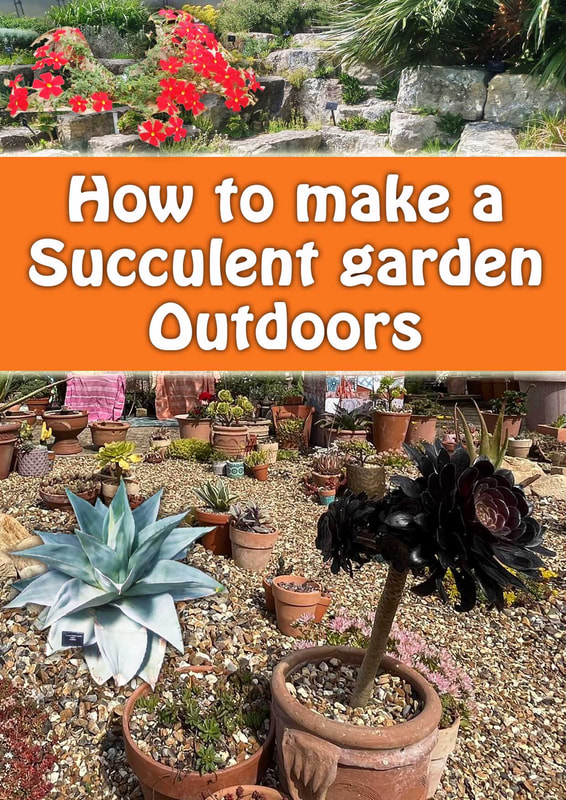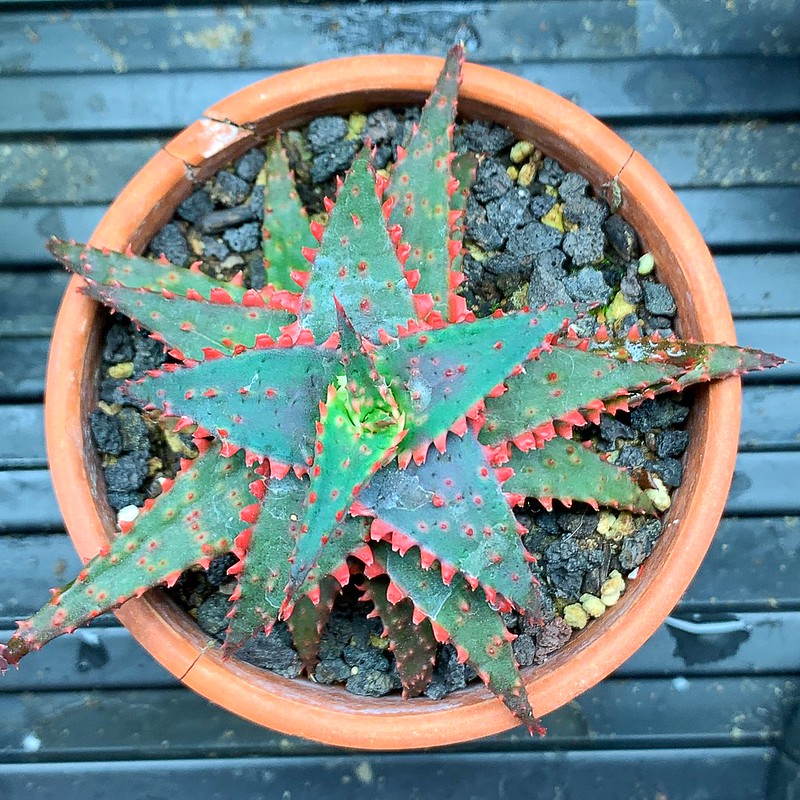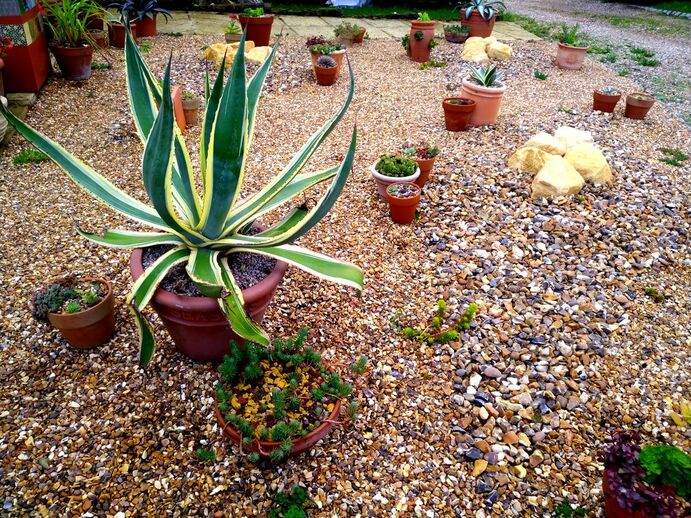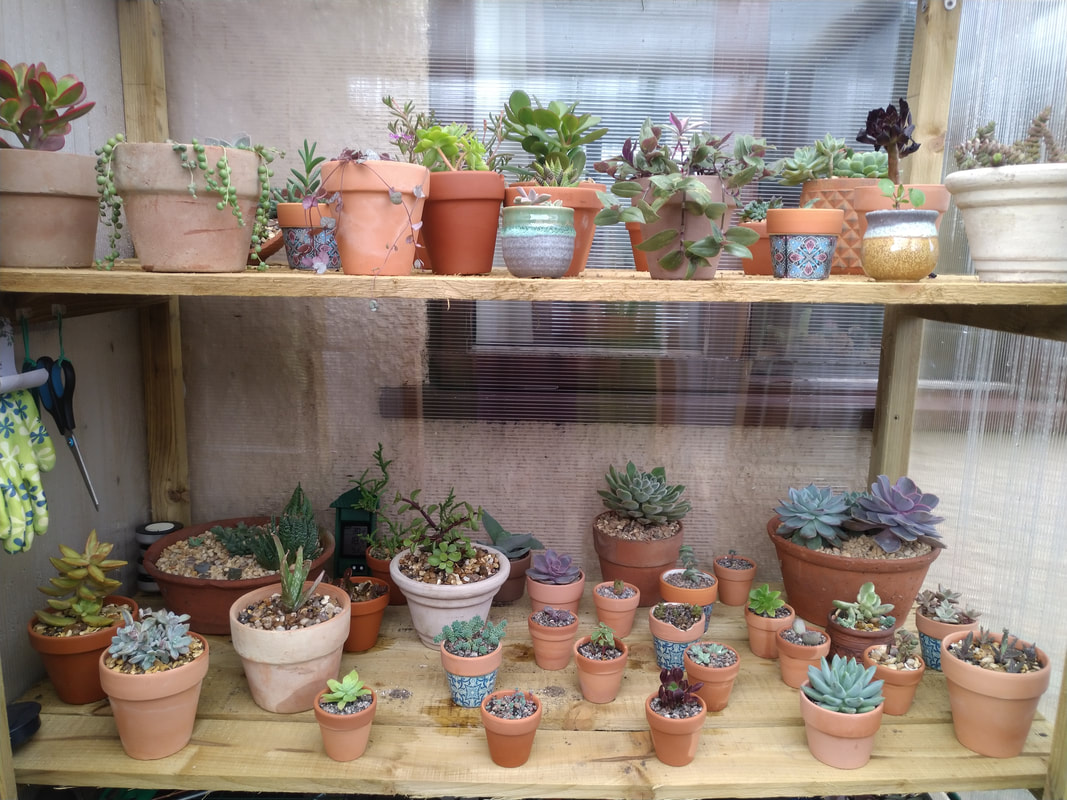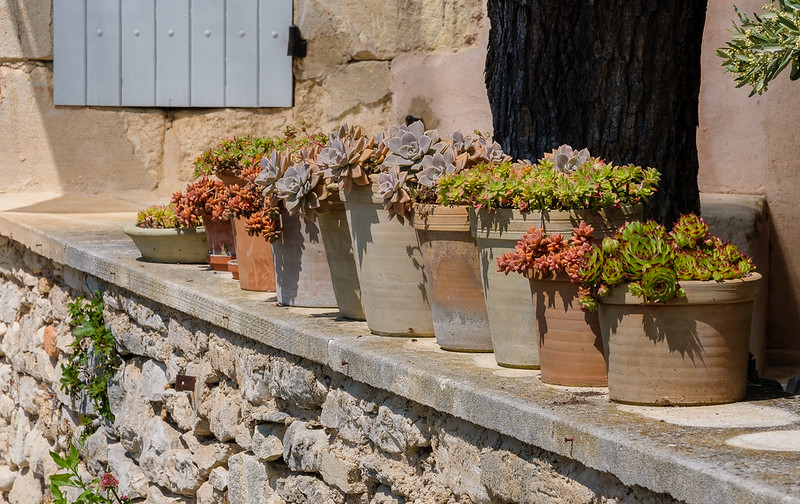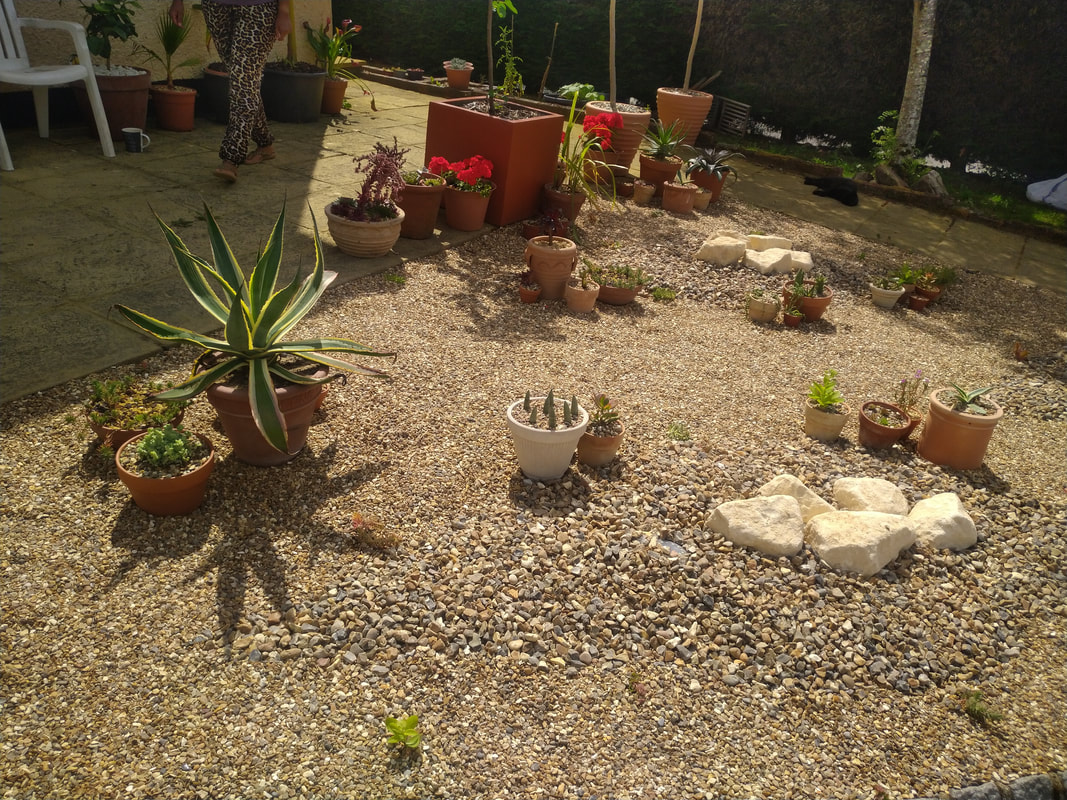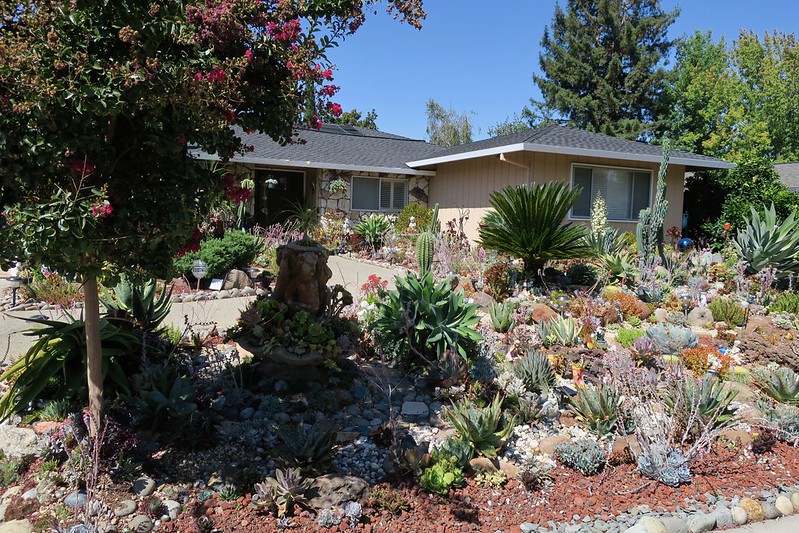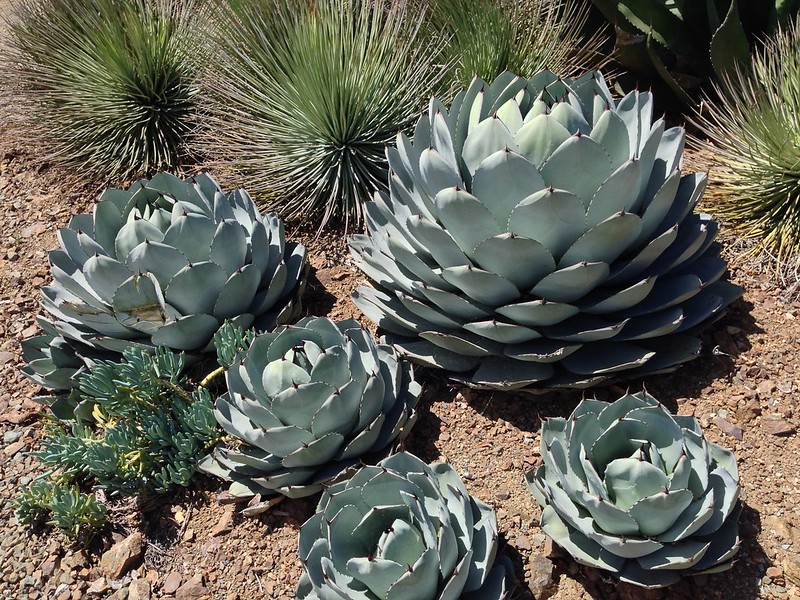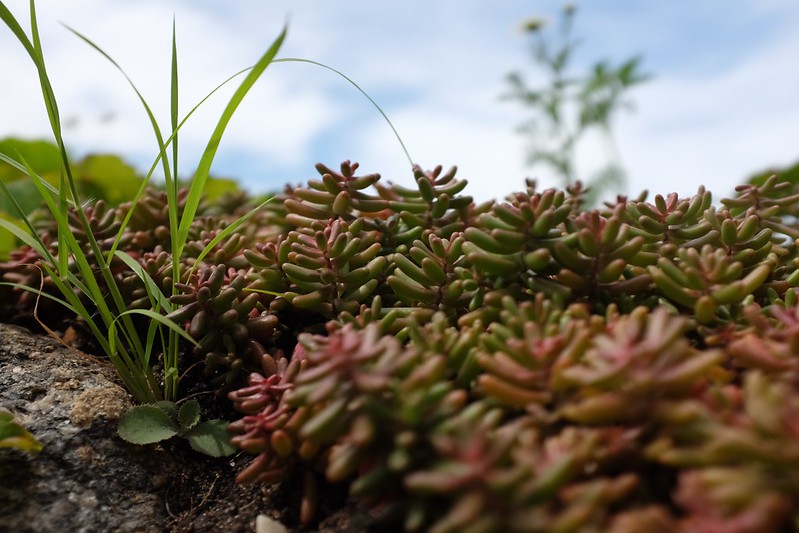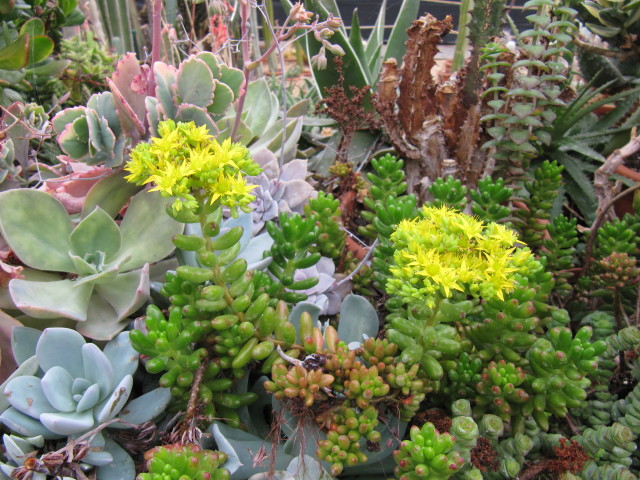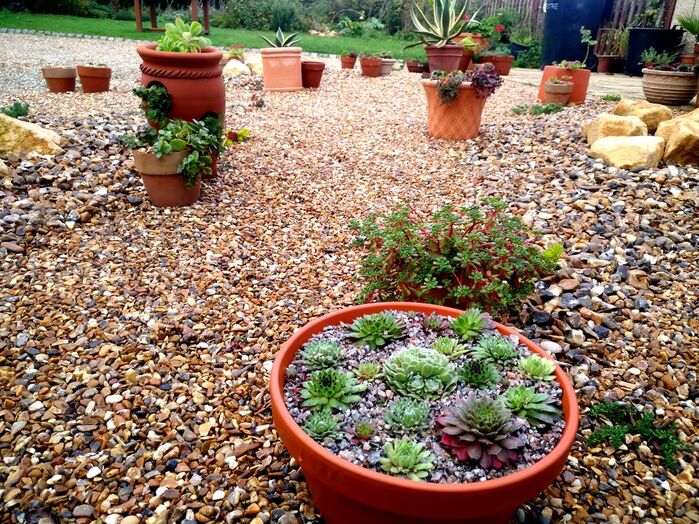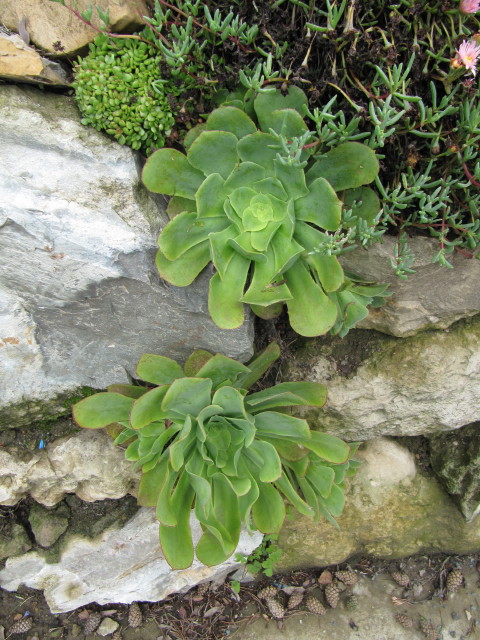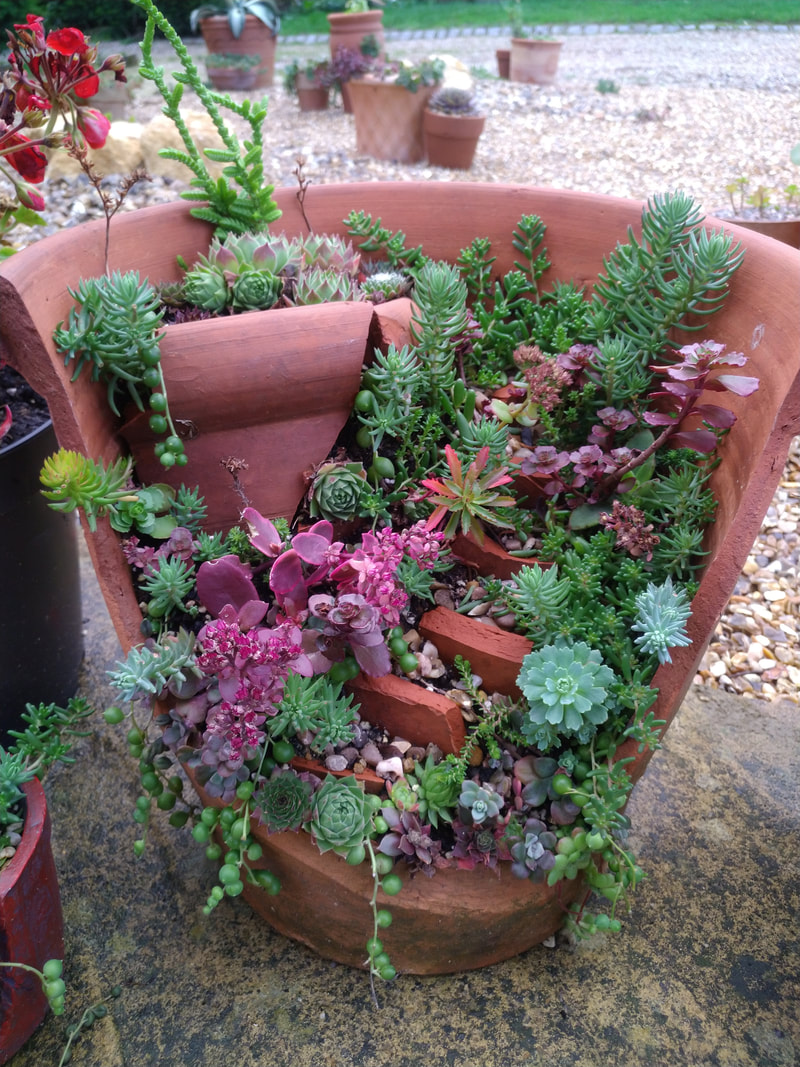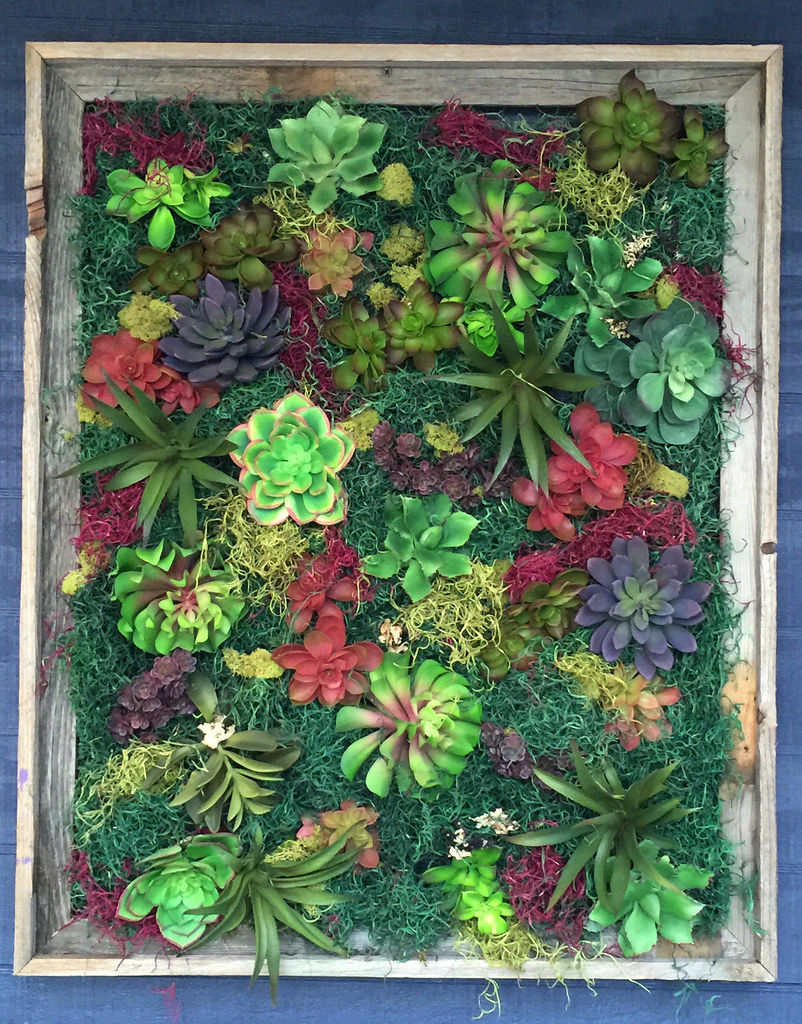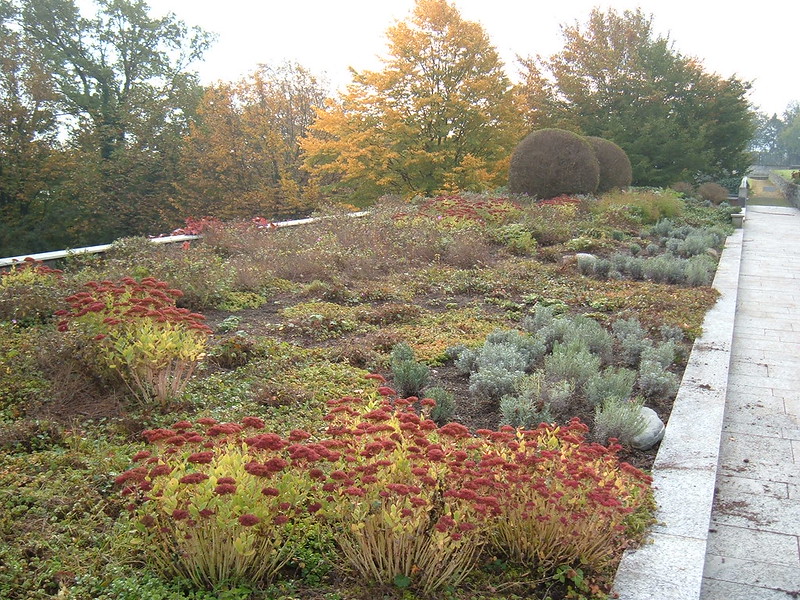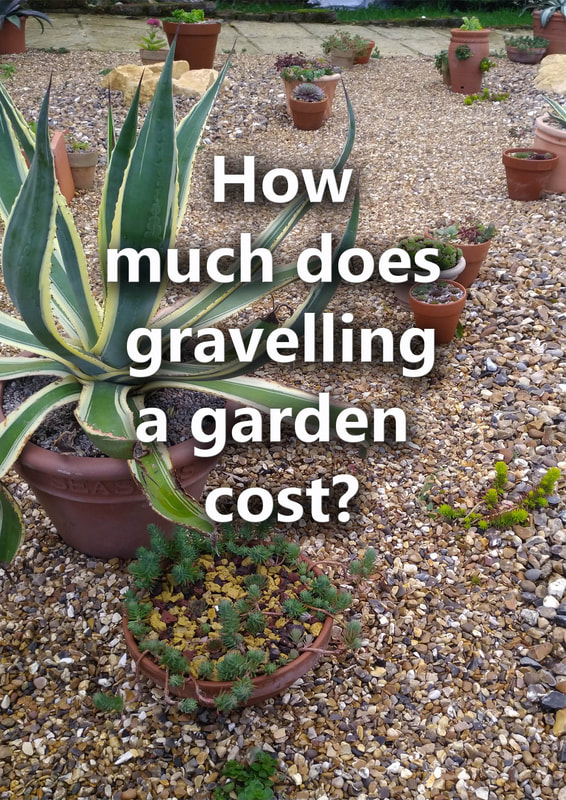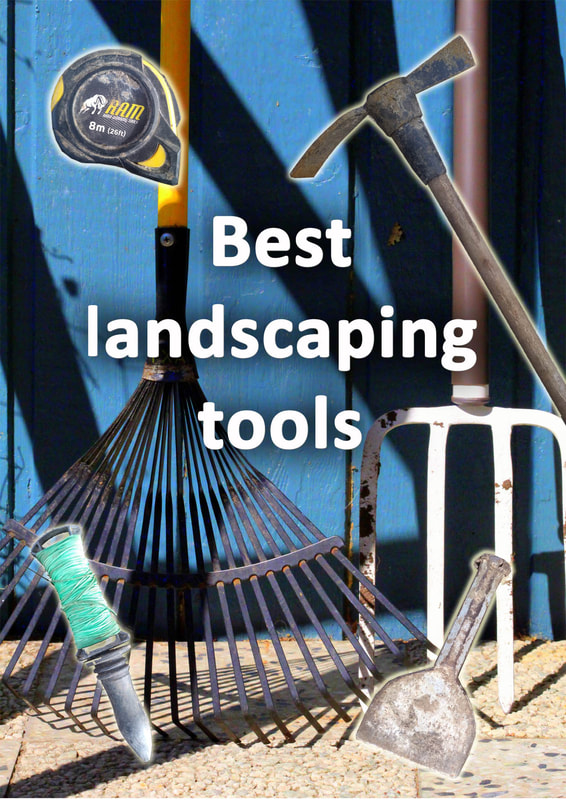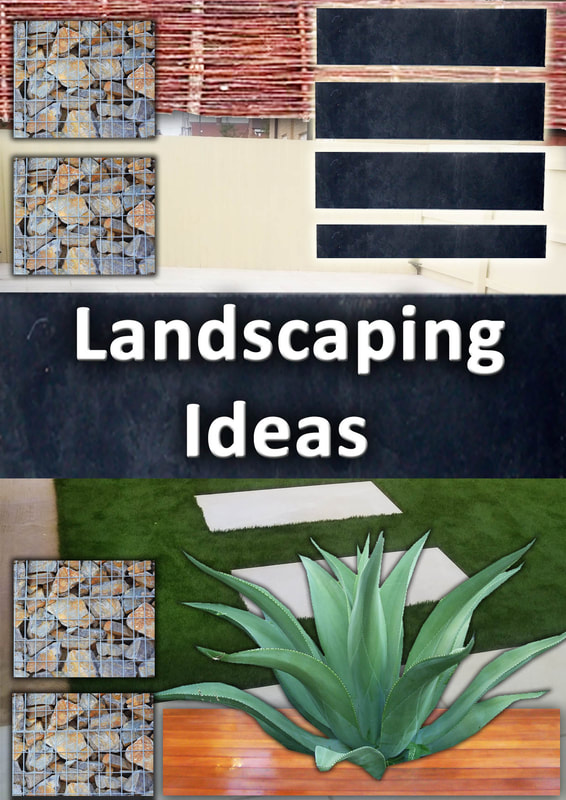|
This article contains affiliate links
Succulent gardens are the perfect way to show off your succulents. Originating from generally dry and arid regions succulents are perfect for dry situations.
Being drought tolerant and slow growing succulents do not require the same level of care as other plants. This makes them ideal for pots or well drained garden borders or rockeries. In this article we will show you how to make the perfect succulent garden bed or border outside. The succulent garden featured in this article has a desert feel to it and based on a dry river bed design. The garden is adjacent to a sun loving patio with a Moroccan or Mediterranean design. We will show you how to make a succulent garden this way covering everything from ground preparation, climate, watering and species selection. What are succulents?
Succulents are a group of dry loving plants which store water within their leaves. Due to their love of environments with less annual rainfall they form a tight, compact growing habit.
Similar to cacti Succulents form a thick leathery surface to help retain water within their core. This growing habit has mean succulents can look extremely decorative. Some look so ornate they actually look artificial. This unusual aesthetic has resulted in a general popularity in keeping succulents. Succulents come in a wide range of sizes, shapes and forms. All of these require varying levels of warmth, moisture and care. How to grow succulents outside?
On the surface the idea of growing succulents may seem easy. However there are a few things you will have to take into consideration when growing succulents. Some species are easier to grow than others with very specific growing requirements. Some are from countries that never see cold temperatures and some are surprisingly hardy.
If you want to grow a succulent garden bed outside you will have to get to know your specific sedums limitations. You will also have to get to know about your local; climate, soil, rainfall, and frost dates. On the whole most succulents can tolerate some cold, night time temperatures. The biggest threat to growing succulents outside is lack of shelter and excessive moisture. The six month on six month off method
If you live in a cold climate the best way to create an outside succulent garden is by keeping plants in pots. These can be brought inside or into a greenhouse every winter. In the Northern hemisphere succulents can be brought outside from late April until late September.
Some succulents like seperverviums and sedums can tolerate excessive rainfall and frost. However if you want your outside succulent garden to have a wide range of species it is best to incorporate this method. Climate
You local climate will make a huge difference to what succulents you can grow outside. Many succulents come from regions such as Latin America, North Africa and the Mediterranean. It is essential therefore when selecting succulents you have an individual knowledge of that species requirements.
Each plant sold usually comes with its minimum and optimum temperature range. Succulents that are of house plant status may only be able to go outside during the summer in cold climates. It is important to remember however that many succulents are from Mediterranean climates. These can cold temperatures and some prolonged rainfall. Therefore as long as the soil is well drained and there is full sun they should thrive. Microclimate
If you live in a cooler climate do not underestimate the power of micro-climate when growing succulents outside. The ‘urban heat island effect’ from hard surfaces and the reflection of solar radiation in urban areas can increase temperate by many degrees. If you have a sunny wall or balcony these can be climatically perfect for succulents even in cooler climates.
Water
Most of the time water is your largest threat when growing succulents outside especially in cold climates. If you are considering leaving succulents outside all year round planting in pots can be a safer option. Succulents do need water however it is extremely important their roots are not continuously saturated.
It is essential that your panting medium is allowed to thoroughly dry out between watering. Most succulents only require a good drink during the warm summer months when they are putting on growth. In cooler, wetter climates succulent garden borders can benefit from urban rain shadow. This is where vertical structures create dry ground where the angle of prevailing wind prevents rain from reaching the ground. These zones can be made even more suitable by erecting horizontal rain covers and lean-tos of transparent materials. These urban ‘dry zones’ are perfect for building raised, outdoor succulent gardens with well drained soil. Growing succulents outdoors in beds is possible in many climates as long as they do not get too saturated with water. Sunlight
The general rule when making succulent gardens outside is as much sunlight as possible. Even through succulents do not photosynthesise as much as other plants sunlight helps to keep them warm and dry.
Always aim to create a succulent garden border in full sun preferably within a sheltered position. This will allow the area to warm up and stay dry. This works especially well where there is a wall or fence behind to reflect heat and light back onto the bed. Soil
Soil is one of the most important elements of starting a succulent garden outside. Succulents like plenty of drainage and do not like nutrient rich soil. If planting in pots mix soil with sharp, sand perlite or grit for extra drainage. This will allow air spaces within the soil so water can permeate freely.
When planting into the soil you will have to get an idea of your gardens moisture content throughout the year. Cooler winter months are when succulents have the highest chance of becoming saturated and dying. Therefore a raised bed is the best way to lift an outside succulent garden away from damp garden soil below. Raised beds
Succulent raised beds can be built with thick timber or masonry construction. Dry stone walling is a great way to build raised succulent gardens outside. Succulents can be planted inside dry crevices and trailing varieties can cascade down the sides of the garden.
If your existing garden soil is exceptionally dry due to impermeable surfaces or free draining substrates there is no need for raised borders. However even in these instances it is extremely advisable to mix plenty of sand, grit or perlite to the ground maximise good drainage. Weeds
Typically succulent gardens outside are susceptible to being colonised by aggressive weeds. For this reason they are commonly planted through weed suppressant membranes and dressed with attractive gravels and aggregates. This helps to achieve an arid look and helps the garden to warm up on sunny days.
If you are worried about extra rainfall during the year plant your succulent on a slight slope and use a waterproof membrane. This will allow rainwater to trickle away over the surface through the gravel. Succulents can be planted on a slight mound within the gravel so the planting hole doesn’t absorb extra water. Making a succulent garden bed outside step by step
When making a succulent garden outside there are many factors to consider. How you go about creating your garden will depend on your own local site and conditions. More often than not the same fundamental stages will apply. We have therefore put together a step by step guide of how to make a succulent garden outside below.
Step 1: Site selection
The first step is selecting a suitable location for your succulent. You may already have an idea of where you want to locate it. Always access you potential site to see if it will suitable to the types of succulent you want to grow.
Will the site get enough sunlight? Will it be well drained enough? Is it sheltered? Will it benefit from rain shadows or microclimate? Is it in a location where you will get to appreciate it and enjoy it? Step 2 : Design
Think about what kind of theme or design you want for your succulent garden. Do you want to go for a miniature desert effect? Perhaps you would like a rockery scheme with trailing succulents cascading over boulders. Outside succulent gardens are great extensions to Mediterranean themed spaces or dry gardens.
Step 3 : Clearance
Clear the area of all existing vegetation or hard standing. If your sites existing state is grass or planting bed remove all vegetation by the roots. Take extra special care get rid of any perennial weeds roots, tubers and bulbs.
If your existing site is hard surfaces such as paving or concrete this will have to be removed and disposed off. Breaking up some of this material may be necessary with a hydraulic breaker. Small fragments of concrete, masonry or sub base can be left in the ground. Make sure the compacted ground underneath is broken up and turned over for good drainage. Step 4 : Ground analysis
At this point it is good to assess your existing ground for its suitability for growing succulents. The most important element will be moisture content. If your ground is seasonally wet it will have to be raised up with extra drainage mixed in.
If you are unsure of your soils existing drainage dig a hole about a spades depth and fill it with water. If the water does not drain with 20 minutes it is too saturated. If your soil has a dark, black look to it then it is probably too high in nutrients. Step 5 : Soil preparation
The best way to prepare the ground of an outside succulent garden bed is to add lots of drainage. If your garden is naturally wet your safest option is to build a raised garden.
Nutrient rich soil or moisture retentive ground should be mixed with sharp sand and grit to up to 50%. This may require removing some garden soil and buying in some free draining material. Step 6 : Applying weed membranes
Due to succulents slow growing nature outside gardens can become overrun with weeds. It is a good idea to apply a robust weed suppressant membrane to your new garden. Succulents can be planted through cut holes in the membrane and planted on a slight mound for added drainage.
Step 7: Spreading aggregates
Weed membranes are not attractive so will have to be covered. Due to succulents habitation of arid, rocky environments it is typical to spread aggregates and decorate gravels around them. This aids yet more drainage and helps borders to warm up quickly in sunlight. Always aim for at least a 25mm layer of aggregate.
Step 8 : Planting
Place out your succulents across the garden border. Move them around until you are happy with their position. When you are happy scrape back the aggregate and cut a small hole in the membrane. Plant your succulents into the ground underneath slightly raised and backfill the aggregate back around the base.
You may want to add some terracotta pots with some less hardy succulents to your garden. These can be taken back inside during winter months or in times of heavy rain. Step 9 : Adding features
You may wish to add extra features to your succulent garden over time. Boulders, contorted logs, statues and water features are all great extra features to add to your garden.
Step 10 : Experimentation
You will not know for sure what succulents will thrive in your garden all year until it is completed. The key with creating successful succulent gardens outside is to experiment. With good research and planning you can identify the best species for your situation.
A year after planting you will have a much better idea of your gardens limitations and potential for the future. By experimentation year on year you will soon become an expert in growing succulents outside in your local area. Options for succulent gardens outside
One thing is certainly for sure, succulents are extremely popular. Not only are they easy to take care of they also look amazing! There architectural forms and almost static outlines make them useful for numerous design themes and styles.
Succulents really are ultimate plants to fit any style garden. From futuristic to tropical to Victorian to contemporary whatever your gardens style succulents will still fit in and look amazing. Below are some typical examples of great ways to implement a succulent garden outside Dry gravel gardens
Probably the most obvious way to integrate succulents outside is a dry or gravel garden. Thematically this is very fitting as succulents generally originate from dry rocky places. This makes them ideal for implementing into Mediterranean gardens, desert gardens and gardens with an arid theme.
In cooler climates hardy succulents such as Agaves combined with gravel gardens can create fabulous and exotic effect. This can add a warming display to the chill and darkness of winter. Elaborate gravels can also inject colour and texture to the garden celebrating succulent’s rigid form. Rockeries
Rockeries by their very nature lend themselves to outside succulent gardens. There typically raised format provides the perfect well drained soil for them to thrive. Many succulents have evolved for hundreds of millions of years alongside rocks and look amazing planted in amongst them in the garden. Rockeries can be large or small and even build on top of areas of hard standing.
Pots
One of the best ways to introduce succulents into your garden is in pots. This is especially true with terracotta as it allows water to slowly drain through its surface. Pots can allow you to take your succulents under cover during times of bad weather. This allows you to grow a more diverse range of less hardy varieties. Pots can be repositioned tweaked as and when you desire allowing you to add and subtract more displays without disturbing the plants themselves.
A succulent wall
Being so drought resistant makes succulents a true conqueror of difficult environments. This is particularly so in urban landscapes with numerous vertical structures. Walls and fences provide the perfect opportunity to grow succulents vertically.
Some varieties have a trailing habit which is perfect for creating a living curtain in your garden. All you need is a simple green wall system which can be fixed to the wall which can hold some soil. These can be bought or with some creativity put together at home. Green roofs
Green roofs are another huge opportunity to grow succulents outside in your garden. Garages, sheds, and even bird boxes all present a great opportunity for these resilient plats. Roof spaces typically receive large amounts of sunlight and are extremely well drained. Not only to succulent roves look great they can protect waterproofing and provide wildlife habitat.
All you need is a root barrier layer, a shallow retaining frame and some free draining substrate. The most common type of succulents used for green roofs are sedums. The warmer your climate the more choice of varieties you will have to plant this way. Unusual planters
Due to succulent’s versatility in terms of both growing conditions and styles really anything goes. The wackier and crazier the better! When starting a succulent garden outside you can plant succulents in almost anything as long as they drain freely. There are many exciting examples of extremely unusual ways to plant succulents outside. They have been planted in old guitars, shoes, sinks and even old toilets!
For more information on growing Cacti & Succulents we recommend: The Complete Illustrated Guide to growing Cacti & Succulents here.
Planning on building your outside succulent garden yourself? Why not visit our Resource page or Recommended landscaping tools article here.
We hope you enjoyed our article on starting a succulent garden outside. If you found it useful why not share it with other like minded succulent lovers?
If you require landscape design or landscaping services do not hesitate Buckinghamshire Landscape Gardeners via the link below.
Our typical operational areas include: Amersham, Aylesbury, Beaconsfield, Berkhamsted, Chalfont, Chesham, Gerard's Cross, Great Missenden, High Wycombe, Princes Risborough and Wendover.
0 Comments
Leave a Reply. |
The Author
|
Landscaping services across Buckinghamshire, Amersham, Aylesbury & High Wycombe
Hyde Heath, Amersham, Buckinghamshire |
|
